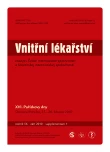Treatment of thrombocytopaenia in gravidity
Authors:
A. Hluší; J. Procházková; V. Krčová; K. Indrák
Authors‘ workplace:
Hemato- onkologická klinika Lékařské fakulty UP a FN Olomouc, přednosta prof. MUDr. Karel Indrák, DrSc.
Published in:
Vnitř Lék 2010; 56(Supplementum 1): 78-80
Category:
16th Parizek's Days, Ostrava-Poruba, March 25th –26th 2010
Overview
Immune thrombocytopaenia (ITP) is an acquired, immune disease characterized by a decrease in blood platelet count. The most frequent cause of thrombocyte deficiency in gravidity is benign gestational thrombocytopaenia, ITP is relatively rare. An optimal management of a pregnant patient with ITP involves good interdisciplinary collaboration between a haematologist, gynaecologist, anaesthesiologist and neonatologist. Depending on thrombocyte count, rigorous haematological follow-up is required. Pharmacological treatment is indicated in only a small proportion of patients and mainly involves administration of corticosteroids and immunoglonulines. After delivery, it is always necessary to assess the newborn for any manifestation of neonatal alloimmune thrombocytopaenia.
Key words:
immune thrombocytopaenia – gravidity – treatment
Sources
1. Bussel JB, Druzin ML, Cines DB et al. Thrombocytopenia in pregnancy. Lancet 1991; 337 : 251.
2. Cines DB, Bussel JB. How I treat idiopathic thrombocytopenic purpura (ITP). Blood 2005; 106 : 2244–2251.
3. Fujimura K, Harada Y, Fujimoto T et al. Nationwide study of idiopathic thrombocytopenic purpura in pregnant women and the clinical influence on neonates. Int J Hematol 2002; 75 : 426–433.
4. George JN, Woolf SH, Raskob GE et al. Idiopathic thrombocytopenic purpura: a practice guideline developed by explicit methods for the American Society of Hematology. Blood 1996; 88 : 3–46.
5. Gill KK, Kelton JG. Management of idiopathic thrombocytopenic purpura in pregnancy. Semin Hematol 2000; 37 : 275–289.
6. Christiaens GC, Nieuwenhuis HK, von dem Borne AE et al. Idiopathic thrombocytopenic purpura in pregnancy: a randomized trial on the effect of antenatal low dose corticosteroids on neonatal platelet count. Br J Obstet Gynaecol 1990; 97 : 893–898.
7. Provan D, Stasi R, Newland AC et al. International consensus report on the investigation and management of primary immune thrombocytopenia. Blood; 2010; 115 : 168–186.
8. Provan D, Newland A, Bolton-Maggs P et al. Guidelines for the investigation and management of idiopathic thrombocytopenic purpura in adults, children and in pregnancy. Br J Haematol 2003; 120 : 574–596.
9. Rolbin SH, Abbott D, Musclow E et al. Epidural anesthesia in pregnant patients with low platelet counts. Obstet Gynecol 1988; 71 : 918–920.
10. Samuels P, Bussel JB, Braitman LE et al. Estimation of the risk of thrombocytopenia in the offspring of pregnant women with presumed immune thrombocytopenic purpura. N Engl J Med 1990; 323 : 229–235.
11. Veneri D, Franchini M, Raffaelli R et al. Idiopathic thrombocytopenic purpura in pregnancy: Analysis of 43 consecutive cases followed at a single Italian institution. Ann Hematol 2006; 85 : 552–554.
Labels
Diabetology Endocrinology Internal medicineArticle was published in
Internal Medicine

2010 Issue Supplementum 1
Most read in this issue
- Thrombocytopenia and coagulopathy in hepatopathy: an introduction into the issue
- Monitoring of coagulation parameters and options to influence them in patients with liver cirrhosis prior to invasive procedures
- Differential diagnosis of thrombocytopaenia in pregnancy
- The application of IPF (Immature platelet fraction) in laboratory diagnostics
